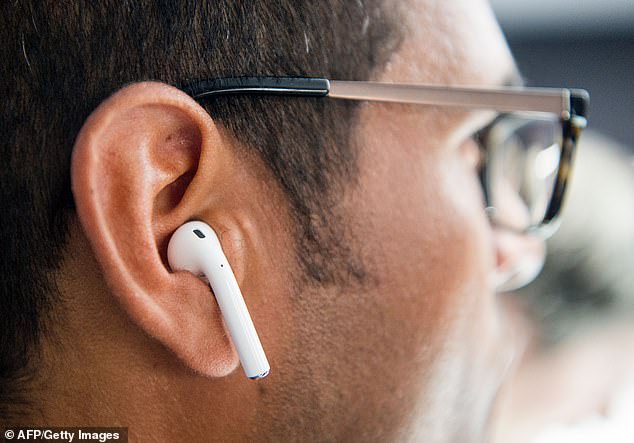Experts Warn That Apple’s AirPods Could Send An Electromagnetic Field Through Your Brain
- Home
- Experts Warn That Apple’s AirPods Could Send An Electromagnetic Field Through Your Brain

Experts Warn That Apple’s AirPods Could Send An Electromagnetic Field Through Your Brain

Scientists are growing increasingly concerned over the potential health risks of wireless technologies which, they say, national and international regulations ‘fail’ to limit.
And new technologies are arriving every day – and customers can’t buy them fast enough.
Apple’s wireless AirPods, for example, ‘communicate with one another using a magnetic induction field, a variable magnetic field [one] sends through your brain to communicate with the other,’ explains Dr Joel Moskowitz.
Dr Moskowitz, a University of California, Berkeley community health professor who focuses on cell phone exposures, says there isn’t even research on what this could do to the brain yet, let alone regulations to limit the potential effects.
‘But I couldn’t imagine it’s all that great for you,’ he says.
Wireless technologies are simply outpacing both research and regulation – and it could have disastrous effects for our health.
A petition warning that microwave radiation from many popular wireless technologies may pose health risks has gathered 250 signatures.
While the scientific jury is still out on the whether or not particular devices an cause cancer, animal studies on the kind of radiofrequency radiation that they emit – which is used in Bluetooth, cellular and wifi transmissions – has suggested a link to cancer.
And, in some cases, the levels of radiation found to be carcinogenic were significantly lower than the maximum allowed by federal and international guidelines.
Last year, Apple sold 28 million pairs of its tiny, white wireless earbuds. The year before, they sold 16 million pairs. With a new design reportedly on the way, the technology company is set to profit even more on sound.
Together, Apple and Beats wireless headphones account for 40 percent of the product market.
But the devices could be pumping more than beats into wearers’ heads.
AirPods – like most small wireless bud-style headphones – wirelessly connect with a phone via Bluetooth, the popular short distance radio communication technology.
Essentially, anything that communicates wirelessly using electromagnetic energy waves of varying types.
Bluetooth operates on one form involving low-power radiowaves.
The most obvious and well-established risk of radiowaves is that, at high levels, they can generate heat and cause burns. Scientists are still working out the effects of long-term exposure to lower-power radiowaves.
When they have exposed animals to this form of radiation, reproductive, neurological and genetic damage has become more common in those animals than would be expected in a normal sample of the same animals.
These forms of energy are powerful enough to shake up atoms that compose cells but not powerful enough to fundamentally change their structures.
This means that radiowaves are less dangerous than higher energy radiation like X-rays or UV, but more extremely low-frequency radiation.
Last year, further evidence that cellular transmissions may indeed cause certain kinds of cancer was published by the National Institutes of Health (NIH).
Now, scientists calling for more oversight and warnings for all manner of radiowave-based technologies are particularly concerned over the intensity and proximity of Bluetooth radiation to the human ear canal and brain.
The International Agency for Research on Cancer has declared electromagenetic field radiation a possible carcinogen.
WiFi, too, has been shown to pose cancer risks.
The World Health Organization (WHO) has developed guidelines for the level of electromagnetic frequency (EMF) that various devices are allowed to expose users to.
But, the authors of the petition to the UN and WHO argue, research has revealed evidence that EMF may be carcinogenic at even lower levels.
And brain cancers are among the forms that research links to EMF radiation.
Their petition is written with regard to broad human exposures to to EMF radiation.
‘These include – but are not limited to … devices such as cellular and cordless phones and their base stations, Wi-Fi, broadcast antennas, smart meters, and baby monitors as well as electric devices and infra-structures used in the delivery of electricity that generate extremely-low frequency electromagnetic field (ELF EMF),’ the authors write.
The petitioners stop short of naming Bluetooth or any particular products, the technology does use radiofrequency radiation, and AirPods in particular also use an electromagnetic field.
Very little research has been conducted on Bluetooth itself, but the proximity of AirPods to the brain makes them particularly concerning.
‘Since Bluetooth tends to be low-intensity it could open the blood-brain barrier, which evolved to keep large molecules out of the brain,’ explains Dr Moskowitz.
The concern there is ‘probably more neurological disorders and diseases as opposed to cancer,’ he adds.
Related research on cancer and EMF has also revealed that cell phone radiation – which is not unlike that which comes from Bluetooth may cause non-cancerous tumors to form along the nerve that connects the brain and the ear.
Plus, the magnetic field the two AirPods use to talk to each other must pass through the brain.
‘From a precautionary standpoint, I would argue you shouldn’t experiment with your brain like this by keeping these kind of wireless headphones on your head or in your ears,’ says Dr Moskowitz.
‘You’re conducting a health experiment on yourself, and current regulations are completely oblivious to these kinds of exposures.’
A great deal more research needs to be done to clarify the exact risks associated with each kind of EMF, but the petitioning scientists believe that our current use of these technologies throws caution dangerously to the wind and they want to hould regulators accountable.
‘The various agencies setting safety standards have failed to impose sufficient guidelines to protect the general public, particularly children who are more vulnerable to the effects of EMF,’ they wrote.
‘By not taking action, the WHO is failing to fulfill its role as the preeminent international public health agency.’
Source: Daily Mail
- Share
Classic Ghana
Classic Ghana brings you into a fun world of arts, entertainment, fashion, beauty, photography, culture and all things in between. Let’s explore these together!







